|
|
 |
|
|
Pickup & Delivery
• Frame repair
• Frame touch up
• Frame refinishing
|
Prompt and Courteous Service
• Rewebbing
• Spring replacement
• Spring repair & re-tying |
Guaranteed Workmanship
• Re-stuffing of cushions
• New foam cushion inserts
• Fabric repairs |
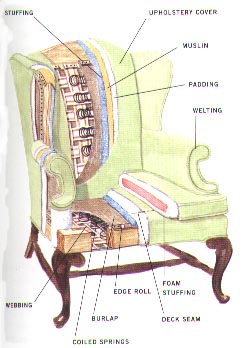 |
Reasons to Re-Uphholster
• Sentimental value of furniture
• Restore Family Heirlooms
• Green or sustainable design that is
ecologically friendly
• Increase the value by restoring an antique
piece
• Re-upholstering can cost less than buying new! |
| Frames - Hardwoods are the key to a quality job |
 |
Good frames are made of hardwood - Oak, Maple, Ash, Alder or Mahogany. These woods are strong and enduring and the upholsterer can tell them by their weight. They're heavy! That's why salespeople will often lift up one end of a 90" sofa when showing it to a customer. They are indicating a quality feature of the furniture, which is the frame's weight.
Good frames are joined with double dowels (wood pins) and wood blocks, or screws. These hold fast and firm for a long time. If and when they loosen, they're easily firmed up, repaired or replaced.
If an old sofa (or chair) frame has stood up for ten years or more, it's probably a quality frame or it wouldn't have lasted that long. Good frames don't wear out. Over the years a good wood frame has become more expensive but is well worth it in the long run. |
| The Guts |
| The guts or components that make up an upholstered piece of furniture are the predominant factor of quality and comfort. These are the parts you don't see and are covered by the foam, padding and fabric. They are however the most important factors in determining the overall comfort of the seating. Chairs or sofas that are bouncy, hard or just plainly uncomfortable usually do not have the correct spring, spring firmness or correct number of springs in the deck. |
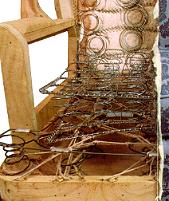 | |
Coil Springs

8-Way Hand Tie

| |
The coil springs can be tied at different levels for different degrees of firmness. The more they are pulled down, the firmer the seating. Firm, medium-firm, or hard, the hand-tied coil spring will always have g-i-v-e. The number of coil springs in the deck will also determine comfort and wear quality.
The 8-way hand-tied spring is the mark of quality and a byword in the industry. But the consumer can be somewhat mystified and is apt to respond with, "It sounds good but what does it mean?" It means you'll never be sorry. The 8-way hand-tie uses coil springs which are the strongest, most resilient, flexible and longest lasting type of spring. Although a coil or two may give up, break or come loose over time, they practically never give out. The springs are tied together in eight directions with twine to provide proper stability within the spring deck and keep the springs from shifting. The springs can also be tied with downward pressure which will provide different degrees of firmness. |
Helical Springs
 |
Helical or Zig-zag springs are also hand-tied. They are S-shaped, simpler in construction, and are used in frames that take stresses differently and for which they are more appropriate. They have come into use more recently than the coil spring, and are attached to the frame, with clips. They usually provide a stiffer seat and sometimes tend to be bouncy. |
Webbing
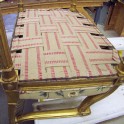
|
Webbing supports the springs of the sofa or upholstered armchair. Webbing comes in strips about 3½ inches wide and it's stretched across the deck (or frame) and woven back and forth like the reed strips in a basket. Webbing is also put on chair seats that have pads and no springs. It is also put on seats and backs of fully upholstered chairs.
There are three types of webbing available: Nylon, which is serviceable and least expensive but not the longest wearing. Jute, an imported fiber from India preferred for quality and strength, and polyester, the latest in use and said to be very long lasting and durable. |
|
| |
|
Fillings provide the comfort on seats and backs of upholstered furniture, and also influence the shaping. They vary from down, which gives a rich, plushy softness–to hair blends for the firmest seatings.
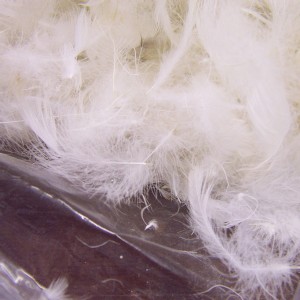
|
Down - Now that full and plump cushions and seatings are in fashion, a down and feather mix filling is used in matching pillows and seating. Down is the most expensive filling available. It is seductively soft and is the traditional luxury filling. The only drawback to a down filling is that after repeated use, the down tends to crush, breakdown and lose its loft. It is best to use a 50% Down and 50 % Feather mix. The higher the feather to down ratio in the mix, the longer the life of the filling as feathers do not crush as easily as the down. To keep the pillows and cushions looking their best, they must be fluffed by gently beating and shaking as a means to revive and get air back into them.
|
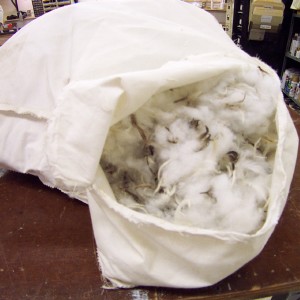 |
Blendown - Blendown offers extra plump and extra soft cushion fillings because they are filled with Polyester fiber fill and a mix of down and feathers. Blendown cushions are soft and cushy like 100% down but maintain their "loft" after sitting on them. These cushions require little maintainence because the Polyester blend filling is resilient and helps the cushion bounce back into shape once sat upon. This filling is recommended for high use seating that looks like down but does not require the maintainence of down. And, like down, these cushions should be fluffed once in a while to retain their shape and look their best. The inner or case that contains the filling usually has baffles sewn at intervals to prevent the filling from shifting and clumping. |
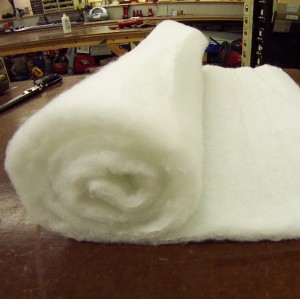 |
Polyester Fiber-Fill - is made in rolls of varying thicknesses. Polyester can be used alone or as a wrapping for polyfoam cushions. It provides a smooth, rounded and soft cushion and is an excellent contemporary filling. Polyester Fiber is usually wrapped and glued around foam inserts and is typically used with all styles and types of furniture. |
 |
Polyurethane Foam - Polyurethane foam is a popular and reliable material that does a good job at shaping and stuffing, and comes in different densities for different degrees of firmness: Soft, Medium, Firm, Extra Firm, Super Resilient (SR) and High Resiliency (HR) for the most firm. Newer foams belonging the the High Resilience (HR) family offer a soft, initial feel and then firm up as more pressure is put on it...thus yielding very comfortable and supportive seating.
|
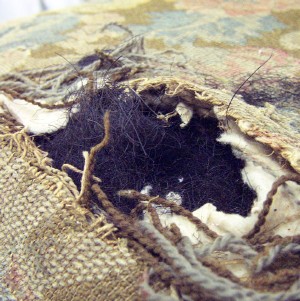 |
Hair Padding - is the firmest of all padding. It used to be horsehair, the kind that plumped up the old Victorian sofa on which the properties of sitting stiffly on an unyielding surface were the manners of the day. Today, the filling is more flexible and inviting, and it's hogs-hair or cattle hair mixed with other fibers for a kinder feel and better resilience. It gives first-class firmness and has a long, sturdy life with plenty of comfort and bounce.
|
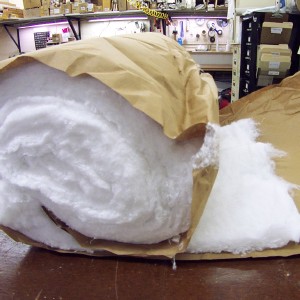 |
Cotton Blend - Cotton blend padding is considered the best type of padding because it wears very well. Cotton blend padding has been used for many years and is tried and true. The cotton is mixed with a bit of felt and fabricated in rolls and is available in different grades and thicknesses. The cotton blend padding is typically applied to a thickness of about 1¾" directly under the fabric and is usually the last layer of padding before the fabric is applied. |
|
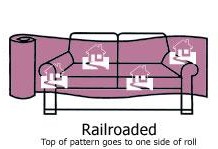
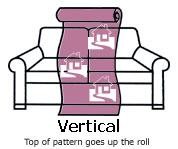
Fabric Orientation
Fabrics are available in a vertical or railroaded orientation as shown above. Be sure to check the tag on the fabric sample to see if the fabric is available as vertical or railroaded as this could effect how much fabric will be required for the project.
|
Fabric Tips
All silk and very light weight fabric should be backed with knit backing or pellon stabilizer to improve workability and reduce warping and the showing of staple tracks. |
|
When purchasing fabrics, keep in mind that many drapery fabrics are suitable for upholstery and are often used as much if not more than regular upholstery fabrics. Fabrics are available in many colors, patterns, textures and weaves. Some fabric considerations are listed below.
Wear Quality
How do you judge a fabric for wear? A classic standard applies here, as used by the professionals: "The tighter the weave, the longer the wear." The standard is threads per inch. One square inch of fabric with 8 or 10 thick threads doesn't have the strength of one square inch of densely packed 30 to 40 thin threads. Specifically: A woven cotton tapestry, where the colors and pattern are tightly woven in with colored threads, wears better than a cotton with the colors printed on. To check a fabric yourself, hold it up to the light. The less light that shows through, the tighter the weave. A good upholsterer will also advise on which fabrics should wear best for they know fabrics and can clue you in to the best textures and constructions.
Fibers and Blends
Fibers also make a difference in wear. Natural fibers, like cotton or silk, take color differently than man-made fibers. Natural fibers can be richer, more subtle, while the man-mades have resilience and strength. That is how the "blends" came into use. Cotton mixed with polyester, for example, yeilds the best attributes of both. Other blends will use nylon, acrylic, rayon. Man-made fibers alone (far advanced over the earlier versions) make many attractive and long wearing pieces. Many fabrics currently available today have such a great look and feel, it is hard to dicern if they are natural or man-made.
Texture Types
The appearance of certain textures will vary with use. Fabrics with a nap, like velvets and corduroys, look different in different lights, and show wear where they've been sat upon. Silks are more delicate, but many are fortified with a man-made fiber. Fabrics with highly textured surfaces, like loopy tweeds and homespuns can "pull" after a while and catch on clothing. Flat weaves, like the cottons, damasks, jacquards, and close-grained tightly ribbed cottons stand up well.
Soil Resistance & Cleanability
For cleanability, each fiber has its compensating feature. Natural fibers absorb soil faster than man-made fibers, but clean better. While man-made fibers are more soil resistant, but don't always clean as well. Many fabrics are treated with soil-resistant finishes such as Teflon or Scotch Gaurd, but the finish doesn't last forever, so be prepared after a time, to have the upholstery cleaned. Fabric protection treatments are well worth the money and have proven their value within the industry. Click here to learn more about fabric protection. |
|

|
|